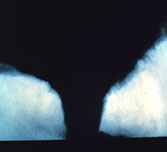Field Programs
VORTEX2 is a field experiment proposed for 2009 that will use mobile radars, dual-polarized radars, unmanned aerial vehicles (UAV's), precipitation microphysics probes, and high-density surface observations to gather valuable data to improve our understanding of the storm processes that lead to tornadoes as well as increasing our understanding of how precipitation processes effect storm evolution. These data will be used to improve precipitation parameterizations in storm-scale models.
Operations
Microphysical parameters derived from just WSR-88D reflectivity and velocity observations are limited. The dual-pol upgrade to WSR-88D will provide valuable information about hydrometeor shape and size distribution. Another area SWAP will study is how improved mesoscale observations from surface mesonets and satellite have the potential to improve forecasts.
Precipitation Microphysics and Cold Pools
Data from a mobile mesonet, including state variables and disdrometer measurements, as well as data from deployable surface sensors, unmanned aerial vehicles (UAV's) and polarimetric radar, and targeted soundings will also improve precipitation microphysics parameterizations.
Mesoscale/Storm-scale Data Assimilation
SWAP plans to analyze storm environments in real-time by assimilating standard observations such as surface observations and WSR-88D into the Weather Research and Forecasting Model (WRF) - with the goal of identifying favorable regions for tornadic storms on the county scale. By coupling the mesoscale model with even higher resolution storm-scale grids, SWAP hopes to capture both the larger scale environment and the tornadic storm via a sophisticated advanced data assimilation and numerical weather prediction system that incorporates all available observations.

